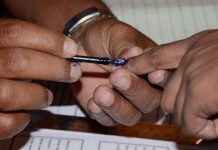Ganesh Iyer
India’s first accredited water sommelier
Edited Excerpts from an interview •
 You don a very unusual mantle that not many are familiar with. What involves being a water sommelier?
You don a very unusual mantle that not many are familiar with. What involves being a water sommelier?
People are accustomed to a wine sommelier but not someone like me. A water sommelier essentially is someone who is able to detect, recognise, and distinct between different types of natural mineral waters. This differentiation is based on various factors — mineral composition, virginality, hardness, pH level of the water and the region where it is sourced from. When you taste water on these parameters, you can differentiate, and a water sommelier does the same by tasting and smelling water. By taking a small sip, I can gauge the TDS levels of water, whether it feels heavy on the palate, is alkaline or acidic.
What prompted you to get into this realm?
I did not decide per se to get into the water business. I have been associated with the beverage industry for 25 years now, having worked with top alcohol and non-alcohol brands. Veen is the 7th water brand that I have launched in India after bringing other names like Himalayan, Qua, Perrier. During this time, I felt the market was bombarded with plastic and started reading a lot about the ill-effects of this on humans and environment. I realised it was high time people here moved away from this unhealthy practice. If you go to any fine dine globally, they don’t use plastic, only glass bottles. Plastic is slotted only for home consumption and super markets abroad, and unlike India, it is safe grade too. So I knew that before introducing glass bottles in this nascent industry, it was imperative for me to have a deeper understanding of the technicalities of water. This was 2008-09 when water sommelier was a novel concept even in Europe. So a few years after joining Veen, I felt I should validate my experience of over two decades and enrolled myself for a 16-day course in Munich which is the only residential programme that familiarises you with water’s finer nuances. We have field visits, theoretical and practical examinations as well which one has to clear to be recognised as a water sommelier.
You dispelled a well-seated belief that water is not odourless. How do you smell water?
Contrary to what we have studied in school that water is tasteless, colourless and odourless, vo jhooth hai! (laughs). Water has a definite taste and has odour too- not malodour but a typical aroma of its own. It does not have to smell like mogra or jasmine for example. Yes, a layman cannot figure out the sodium content or pH by simply smelling it. Thereby, determining sodium, magnesium or other components of water makes the task of a water sommelier very complex. One can easily respond to phoney words like woody, cherry, peaty when a wine sommelier explains wine because we have consumed it. A water sommelier, however, cannot floor his audience by asking – are you getting the flavour of sodium, do you get a whiff of magnesium. They will be like — we are not chemists! So there is a ready reckoner of 21 off-flavours figured out by some German scientists that one relate closest to each of the minerals present in water. For instance, rotten egg has a very sulphuric smell, which shows that the water has high sulphur content. Then there is a smell of freshly cut cabbage. When you have very heavy velvety feeling on your palate, the water is silicone rich.
Since you comprehend water’s properties so minutely, do you also discern how to pair it with food?
(Smiles) I am equipped to recommend water pairings with food but currently I choose not to do it because we are at a sub-primary level of creating awareness for the consumers. So if I were to do pairing water with food, wine or whiskey, then I would be simply playing to the gallery. I do not want to do this in India because we are light years behind in knowing what is natural mineral water, what is packaged drinking water, why not to use plastic and switch to glass. A lot of training and education is required at the moment. It would be foolish of me to skip these few steps and go straight to this frivolity even though it has a lot of theatre and drama and makes for a great readable story. Currently, the emergent need is to get our basics right — focus on natural mineral water being the healthy alternative, discarding packaged water from our lives, and consuming organic products.
You have repeated often during the conversation that packaged drinking water is harmful. Please elaborate.
This accords more relevance in Indian context because in the absence of regulatory compliances, a lot of us think plastic water bottle is safe. The truth is that they are not safe at all, specially in a tropical country like ours. Internationally, you have BPA- free bottles but in India, we have no surity that the water that we are consuming over the counter is BPA free or not. BPA is bisphenol A, a toxic resin present in most of the plastics. Packaged water changes many hands after it leaves the manufacturing unit — travelling in heat and humidity, going through distributors and finally reaching the end consumer. When these plastic bottles are exposed to heat and humidity, they release BPA chemicals. Consuming this water can lead to cancer. We, however, do not take it seriously because the harm this water does is gradual. It takes 15-20 years to manifest. Had it been immediate, we would have not played with our health.
My advice is to avoid drinking water from plastic bottles as much as possible. Given a choice between packaged water and RO, I would go with latter even though it too is harmful to health because I know it has been processed in the morning and is relatively fresh.
Almost all Indian households now have RO filters. What are your observations about the same and the water that we drink here, in general?
RO water is antithetical to health. Consistent consumption of this water causes deficiency of Vitamin D, and it has been scientifically proven. The best thing is to follow dadi/nani ke nuskhe and boil it before drinking. I drink only boiled water. You should boil RO water too.
Natural mineral water replenishes all the minerals that you have lost through perspiration, high energy exercise, exertion etc.
Water that has less than 0.05 mg per bottle is considered extremely superior water. When this mineral is recorded higher than the prescribed limit, it is harmful to humans. Unfortunately, much of the water in Indian market that comes from Himalayan springs is compromised because of high nitrate quantity. Most water bottling plants are in Himachal Pradesh that also houses countless pharmaceutical companies. The colossal amount of soil and water pollution these units cause is common knowledge.
letters@tehelka.com













